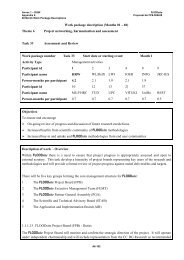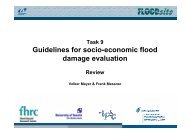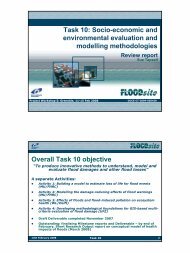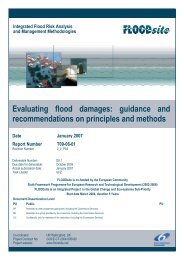Evacuation and traffic management (full report) - FLOODsite
Evacuation and traffic management (full report) - FLOODsite
Evacuation and traffic management (full report) - FLOODsite
You also want an ePaper? Increase the reach of your titles
YUMPU automatically turns print PDFs into web optimized ePapers that Google loves.
Task 17 <strong>Evacuation</strong> D17-1<br />
Contract No:GOCE-CT-2004-505420<br />
• National level.<br />
In the case of an imminent flood posing a threat, the municipality is the primary managerial level for<br />
this type of emergency, with the mayor in comm<strong>and</strong>. However, it will be clear that a flood will<br />
seldom be limited to one municipality’s boundaries. For example, a dike failure will result in an<br />
inundation that will gradually spread out over the protected dike ring area, as shown in Figure 2.3.<br />
During this process more <strong>and</strong> more municipalities may get affected. To cope with this 'supramunicipal'<br />
aspect the individual mayors concerned can choose one of them as the coordinating mayor.<br />
If the flooding remains regional the provincial level of government is involved at an administrative<br />
level. The national government level will of course be informed <strong>and</strong> provide assistance <strong>and</strong> directions<br />
where needed, but it will not lead the operation.<br />
At the provincial level, the provincial governor (the queen's commissioner) is the highest<br />
administrative official. The duties <strong>and</strong> competences of the provincial governor during a regional<br />
emergency will probably change somewhat in the near future, when the recommendations of recent<br />
advice to the government are implemented. Currently under Dutch law the provincial governor can<br />
'direct' <strong>and</strong> assist, but is not in comm<strong>and</strong>.<br />
The province draws up the provincial emergency coordination plan. The governor screens the<br />
municipal emergency <strong>management</strong> plans <strong>and</strong> can enforce changes in such plans. In the case of an<br />
emergency the governor can make available the input of provincial services <strong>and</strong> can act as<br />
intermediary between the (coordinating) mayor <strong>and</strong> regional or governmental institutions for the<br />
supply of assistance. The governor also has the power to give directions to a mayor with regard to the<br />
actions to be taken during an emergency <strong>and</strong> to provide the operational <strong>management</strong> in a 'supramunicipal'<br />
disaster area. In case of a national disaster the Minister of Home Affairs coordinates on the<br />
governmental level with support from the National Coordination Centre.<br />
The chain of functional responsibility with respect to flooding consists of the following organisations:<br />
• The Water Board, which is a regional water <strong>management</strong> organisation <strong>and</strong> responsible for the<br />
primary dikes of one or more dike rings. If the water retaining function of a dike is in jeopardy<br />
the water board has the power to appropriate properties <strong>and</strong> instruct inhabitants in the dike ring to<br />
assist with <strong>and</strong> to make available vehicles <strong>and</strong> tools to combat a threatening inundation.<br />
• The Provincial Water <strong>and</strong> Environment Service supervises the functioning of the water boards.<br />
The service can give instructions to the water boards on supply from or discharge to surface water<br />
that is not managed by government or province.<br />
• The Ministry of Transport, Public Works <strong>and</strong> Water Management <strong>and</strong> its executing agency<br />
Rijkswaterstaat assess water levels that trigger various levels of warning in the main rivers <strong>and</strong> in<br />
the IJsselmeer every year. Rijkswaterstaat's Institute for Inl<strong>and</strong> Water Management <strong>and</strong> Waste<br />
Water Treatment provides actual water levels <strong>and</strong> predictions on a regular basis. In the case of a<br />
threatening flood the frequency of the updates on water level <strong>and</strong> prediction is increased. The<br />
Ministry gives instructions to a province on the supply <strong>and</strong> discharge of water under extreme<br />
conditions.<br />
The main professional emergency rescue <strong>and</strong> aid providers during flood conditions <strong>and</strong> evacuation,<br />
acting under the supervision of the (coordinating) mayor, are:<br />
• The fire brigade, for rescue, technical assistance <strong>and</strong> providing emergency pump capacity.<br />
• The medical <strong>and</strong> public health institutions who provide urgent medical <strong>and</strong> mental health care,<br />
<strong>and</strong> preventive health care.<br />
• The police who maintain public order, criminal inquiries, <strong>traffic</strong> regulation, closing <strong>and</strong> guarding<br />
certain areas, <strong>and</strong> identification of casualties.<br />
• The municipality who is responsible for the registration of victims, burial, damage registration.<br />
T17_07_02_<strong>Evacuation</strong>_<strong>and</strong>_<strong>traffic</strong>_<strong>management</strong>_D17_1_V4_4_P01.doc 19 03 2008<br />
22











